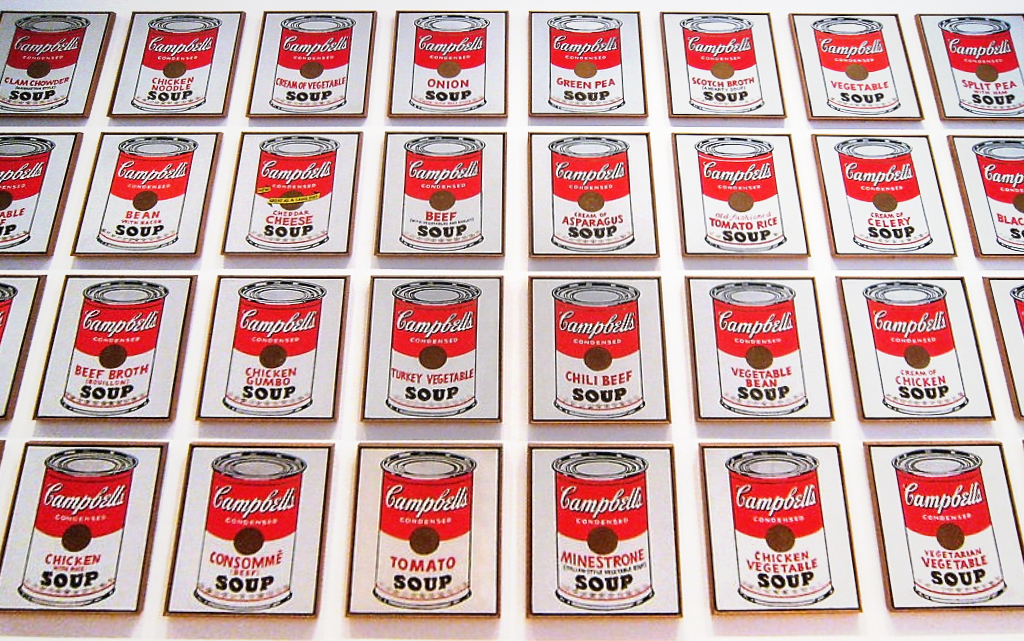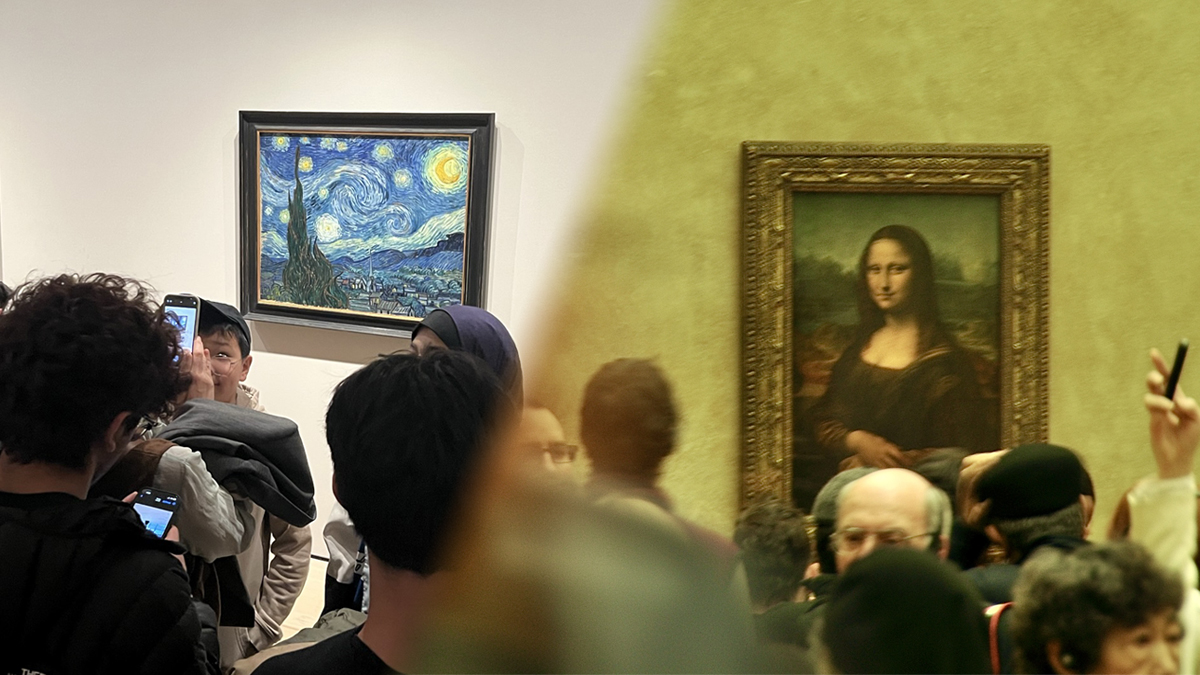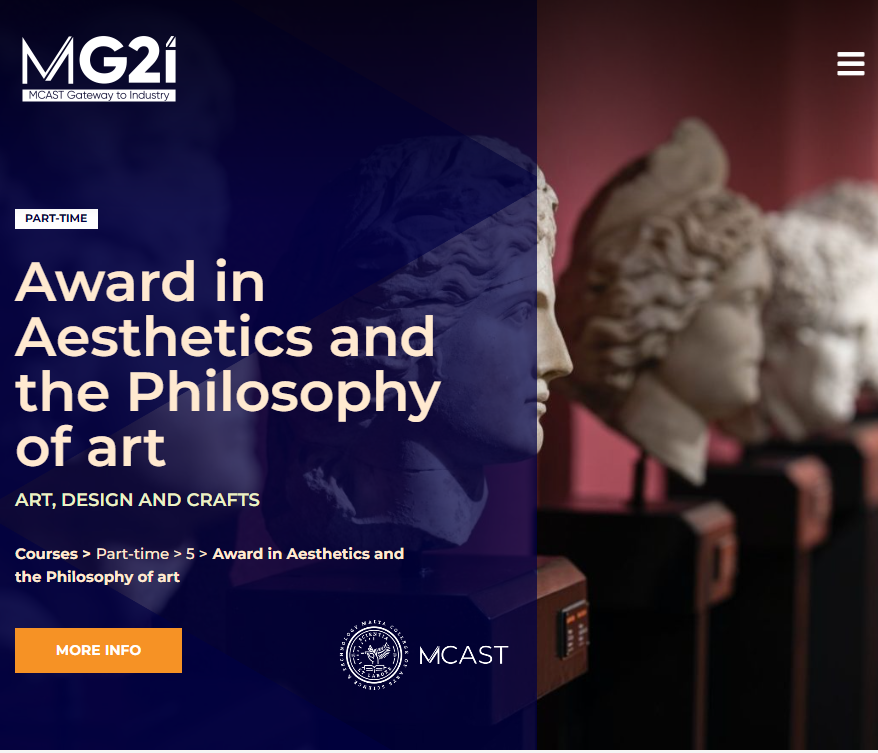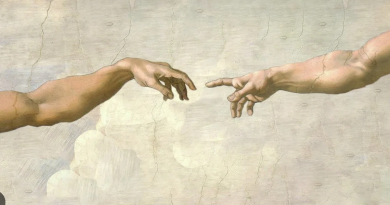Mona Lisa on mugs and mouse mats: Unraveling the pop culture spectacle of iconic art
In the bustling bazaars of modern pop culture, two coveted items sit atop the pedestals of artistic consumerism: Van Gogh’s “Starry Night” at MoMA and Da Vinci’s “Mona Lisa” at the Louvre. These works have become the ultimate bucket list trophies, luring in crowds with selfie sticks like moths to the flame.
As mass-produced symbols of artistry, Van Gogh’s swirling skies and Da Vinci’s enigmatic smile are plastered across coffee mugs, mouse pads, and Instagram feeds. In today’s digital age of Facebook-fueled fame, the masses flock to these works not necessarily for the artistic experience, but for the social validation of standing before their storied canvases.
Part 1: The Rise of Consumer Culture and its Impact on Art
Consumerism is the belief that buying and consuming things, whether they be cars, food, or artworks, is a primary source of happiness and social status. This mindset influences how people perceive and value products, experiences, and even art. In this culture of consumption, individuals often seek to acquire more possessions to achieve satisfaction, resulting in a constant desire for newer, better, and more impressive things.
In this context, art is not immune to the influence of consumerism. The allure of owning, displaying, and being seen in the company of famous works becomes more about social validation than a genuine appreciation of the artistic experience. Masterpieces like “Starry Night” and “Mona Lisa” are transformed into commodities that people want to possess, display, and show off on social media platforms.
This has significant implications for art and its future in a world of mass production and social media. In this post, we’ll delve into the rise of consumer culture and its impact on art, critique the dangers of consumerism, explore pop art as a reflection and critique of consumer culture, and examine the future of art in the age of mass reproduction and social media.
Part 2: The Critique of Consumerism
Intellectuals like Theodor Adorno have criticized consumerism for promoting superficiality and commodifying culture. In his work “Dialectic of Enlightenment” (1944), co-authored with Max Horkheimer, Adorno argued that this mindset leads to a loss of individuality and genuine appreciation for art, as people become more focused on consuming and owning rather than truly understanding the deeper meaning behind artistic creations. The commodification of art, in Adorno’s view, diluted its essence and turned it into just another product to be bought and sold, rather than a profound expression of human emotion and experience.
Other figures from the art world, such as Walter Benjamin, shared similar concerns. In his influential essay, “The Work of Art in the Age of Mechanical Reproduction” (1935), Benjamin discussed the impact of mass reproduction on the aura and authenticity of a work of art. The term “aura” refers to the unique presence and value of an original artwork that cannot be replicated through reproductions. Benjamin argued that the proliferation of art reproductions led to a loss of the original’s unique presence, undermining its value and mystique. This commodification of art and its subsequent devaluation have only been exacerbated by the modern consumer culture, as masterpieces become mere objects to be traded and consumed, detached from their original context and meaning.
In response to Adorno, Benjamin, and other critics, some scholars have argued that the relationship between art and consumer culture is more complex than simply commodification and devaluation. For instance, John Berger, in his influential book “Ways of Seeing” (1972), explored how the reproduction and dissemination of art could democratize access to culture and foster new ways of engaging with and understanding art. He suggested that while mass reproduction might diminish the aura of the original work, it could also liberate art from the confines of the elite and make it accessible to a broader audience.

Part 3: Pop Art: A Reflection and Critique of Consumer Culture
Pop art emerged in the mid-20th century as a reflection on and critique of consumerism. Artists like Andy Warhol and Roy Lichtenstein borrowed imagery from advertising, comic books, and everyday objects to create works that both celebrated and satirized the consumer culture. By using familiar images and mass-produced techniques, pop artists questioned the distinction between high art and popular culture, while also exposing the effects of consumerism on society.
For example, Warhol’s “Campbell’s Soup Cans” (1962) used the iconic soup can design as a commentary on mass production and consumerism. This artwork took an everyday object from the world of advertising and transformed it into a piece of art, blurring the lines between commercial products and artistic creations. Lichtenstein’s “Whaam!” (1963) appropriated comic book imagery to address the relationship between popular culture and fine art. By using recognizable imagery from mass media, Lichtenstein challenged the traditional notion of what constitutes high art.
Their work served as a reminder that art, like any other product, can be influenced by the cultural and economic forces that shape our world. Pop art not only highlighted the pervasiveness of consumer culture but also questioned the commodification and devaluation of art in the age of mass reproduction. By drawing attention to the role of consumerism in shaping our understanding of art, pop artists like Warhol and Lichtenstein contributed to a broader discussion about the impact of consumer culture on our perceptions of value, authenticity, and artistic expression.

Part 4: The Future of Art in the Age of Mass Reproduction and Social Media
As we continue to navigate the digital age and the era of social media, the ongoing impact of consumer culture on art becomes increasingly apparent. Works like “Starry Night” and “Mona Lisa” have ascended from mere masterpieces to full-blown pop culture icons.
“Starry Night” was painted by Van Gogh in 1889 during his stay at an asylum in Saint-Rémy-de-Provence, France. It is considered a representation of his inner turmoil and a reflection of his struggle with mental illness. The “Mona Lisa” is usually thought to have been painted by da Vinci some time around 1505, and is believed to depict Lisa Gherardini, the wife of Florentine merchant Francesco del Giocondo, who commissioned the portrait.
Both have transcended their origins to become the art world’s Kardashians, drawing spectators who crave a touch of glamour by association. In this age of mechanical reproduction and social media obsession, artworks are sought by many and truly understood by few.
Art museums and galleries play a critical role in preserving the value and integrity of artistic expression amidst the pressures of consumerism. By providing a platform for the display and appreciation of art, these institutions help maintain a connection to the original context and meaning of the works. However, they must also navigate the challenges of attracting audiences and sustaining themselves financially, often leading to a delicate balance between preserving artistic integrity and catering to consumer demands.
Contemporary art has seen the emergence of strategies and trends that resist or subvert the commodification of art. Participatory art, for example, invites the audience to engage directly with the artwork, blurring the lines between artist and spectator and challenging the notion of art as a commodity to be passively consumed. Digital art, which encompasses a wide range of artistic practices using digital technology, offers new possibilities for the creation, dissemination, and consumption of art. It can be easily reproduced and shared, potentially democratizing access to art and fostering new forms of artistic collaboration.
Another trend is the growing interest in site-specific and immersive art experiences that cannot be easily replicated or commodified, such as Sarah Sze’s exhibition Timelapse at the Solomon R. Guggenheim Museum, NYC, in 2023. Such works, which are designed to be experienced in a particular context or environment, emphasize the unique, ephemeral nature of the artistic encounter and resist the commodification of the art experience.
While consumer culture continues to impact the art world, artists and institutions are finding innovative ways to resist and subvert the commodification of art. By exploring new forms of artistic expression, engaging audiences more directly, and preserving the unique value of the art experience, one can hope to maintain a vibrant and meaningful art world in the age of mass reproduction and social media.
In an ironic twist, even as we discuss the commodification of iconic art and its implications, our words become part of the very system we critique. By delving into the superficiality of the art world and the role of consumerism, we inadvertently contribute to the ceaseless stream of digital content that feeds our collective hunger for likes, shares, and self-affirmation. It is a paradox of our time: the more we strive to untangle the complexities of superficiality and consumerism in art, the more entwined we become in the intricate web of pop culture’s unending spectacle. Nevertheless, by acknowledging this irony and engaging in thoughtful discourse, we can hope to spark a deeper understanding and appreciation of art in the face of consumerism’s pervasive influence.
Part 5: Read Further
- Gombrich, E. H. (2008). The Story of Art. London: Phaidon Press.
- Adorno, Theodor W., & Horkheimer, Max. (2002). Dialectic of Enlightenment. Stanford, CA: Stanford University Press.
- Benjamin, Walter. (2008). The Work of Art in the Age of Mechanical Reproduction. London: Penguin Books.
- Berger, John. (2008). Ways of Seeing. London: Penguin Books.
- Warhol, Andy, & Lichtenstein, Roy. (2009). Pop Art: A Critical History. Berkeley, CA: University of California Press.
- Huyssen, Andreas. (1986). After the Great Divide: Modernism, Mass Culture, Postmodernism. Bloomington, IN: Indiana University Press.
- Debord, Guy. (1995). The Society of the Spectacle. New York: Zone Books.
- Bourdieu, Pierre. (1993). The Field of Cultural Production. New York: Columbia University Press.
- Foster, Hal, et al. (2004). Art Since 1900: Modernism, Antimodernism, Postmodernism. London: Thames & Hudson.
- Bishop, Claire. (2012). Artificial Hells: Participatory Art and the Politics of Spectatorship. London: Verso Books.




